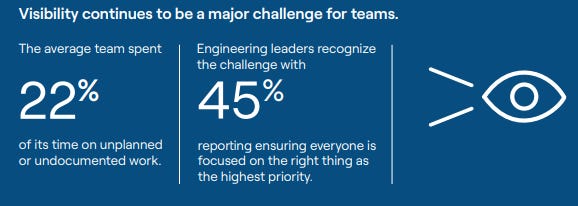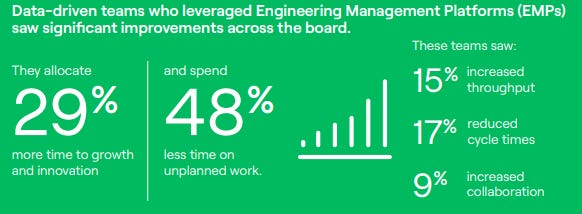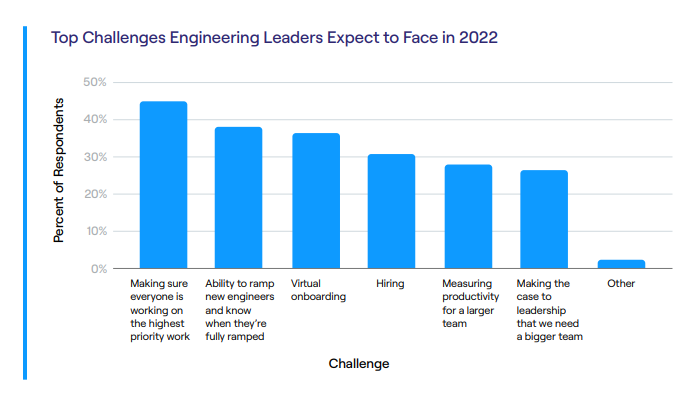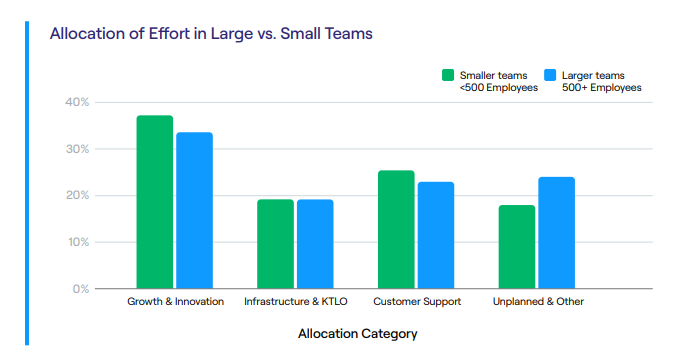Are Software Engineers Becoming More Productive?
Jellyfish survey hints at improvements in Software cycle efficiency
Hey Guys,
Jellyfish Founders, circa 2021 Boston.
Something a bit different this week. The data we get on Engineering teams is changing our view of the profession, both from a software engineer perspective and an Engineering Manager perspective.
An analysis of the time 23,000 software engineers spent working in 2021 that was published this week by Jellyfish, a provider of an engineering management platform (EMP), finds cycle times on average were down to 12.6 days, representing a 12.3% decline over 2020.
If you have no idea who Jellyfish are? I didn’t either. Apparently they raised more money in early 2021. Jellyfish, a software engineering management platform that helps managers align engineering work with business objectives, raised $31.5 million in a series B round of funding led by Insight Partners in 2021.
I decided to take a look at the gated content report which was used to get my Email and some of my personal data. Well, so you don’t have to.
To compile the findings in the report, Jellyfish analyzed 23,000 engineers' work while surveying hundreds of engineering leaders. The insights highlight both the challenges engineering teams face and how management responds.
In their press release they also had some top of mind stats that are vaguely interesting.
Software increasingly leads business strategy, and engineering teams are a critical and resource-intensive part of most corporations. Their work is responsible for driving innovation, revenues and customer loyalty. In its third annual report on the state of engineering management, Jellyfish evaluates where engineering teams are using their time and resources, how they are operating and performing, and how leaders are investing for growth in 2022.
Jellyfish's research found that engineering teams shifted focus on infrastructure work and teams are gearing up for growth, including headcount, customers, and scalability, by doing the work that is needed to support that moving into 2022.
In 2021 the average engineering team allocated 35% of its time to growth and innovation and 19% on infrastructure work, up nearly 6% from 2020 (14%), while support work was down nearly 5% from 29% last year to 24%. In 2021, teams spent 22% of their time on average on unplanned work.
Engineers who are motivated and understand the importance of their work are more productive, as teams who devote 50% or more resources to growth and innovation work deliver software at least 3x faster than those who commit 25% or less.
Key Takeaways
This can also be visualized thus:
Of course they want to push their product as a “must-have” for Software engineering productivity.
Sales aside, I actually find what they do rather interesting. Founded in 2017, Boston-based Jellyfish is setting out to do for engineering team leaders what customer relationship management (CRM) systems have been doing for sales teams for years — using data “to inform decision-making to improve how work is done and how it’s measured.”
So it seems in 2022, Engineers and Data Science professionals might be getting access to better data and CRMs more optimized for their specific verticals.
Engineering Managers
For Engineering managers three things stood out in their research. Three themes stood out as central to their conversations about engineering leadership in 2022: visibility, engineering team productivity, and setting the foundation for the future.
In 2021, Overall, coding days per engineer were down 8% to less than 1.6 days per week in 2021, the report found.
Virtual collaboration in the last year has also increased more than 20% as teams continue to embrace remote and hybrid work models, according to the report
The report also noted that pull request reviews per engineer are up 30% on average to 1.7 reviews per week. Pull review comments per engineer were up 23% year over year.
Interestingly also:
Engineering Mangers
Jellyfish has a company it turns out got another funding round in February of 2022. Jellyfish, essentially pioneered the term “engineering management,” to provide a software tool for insight into engineering organizations, including what they are working on and how they operate, according to TechCrunch.
To continue developing its technology, the company announced a $71 million in Series C investment led by Accel, Insight Partners and Tiger Global, with participation from Wing Venture Capital and other existing investors. The latest round comes a year after it raised $31.5 million in Series B funding. In total, the company has raised just over $114 million. This is not a sponsored post, but I wanted to talk about the company while talking about their report at the same time.
More Report Findings
The company claims in the report that organizations leveraging EMPs focus more on growth and innovation. This makes sense intuitively but could also be a sales gimmick within the report.
The stats if they are true are striking: Engineering organizations using EMPs tend to allocate similar time to “keeping the lights on” and customer support activities, but spend 29% more time on innovation work, and 48% less time on unplanned work.
Are the managers where you work using an EMP to improve efficiency? EMPs stand for of course, Engineering Management Platforms (EMPs).
Allocation Insights
Not surprisingly, smaller organizations (<500 employees) have less unplanned work, and they spend more time devoted to roadmap work as compared to larger organizations (>500 employees). They spend approximately 37% time on growth / innovation work; that figure stands at 34% for large organizations. Smaller organizations also only spend 18% time on unplanned work vs. 24% in larger organizations.
So the difference of how Engineers spend their time at smaller or larger organizations is truly quite more different than I would have expected.
Jellyfish have a hilarious motto I find, Think in Code, Speak in Profit.
Measure engineering work.
Communicate its value.
Deliver business results.
I find it a good intersection between Engineering and business value worth thinking about.
I mean it makes sense right, as all companies transform into software companies, they need visibility into the software that gets built to ensure that it aligns with the priorities of the business. The intersection of productivity and software engineering and data insights is just huge! In a world with Snowflake, Databricks, Datadog and DataRobot world, software and Big Data is evolving.
Will this thing become the “Salesforce of Engineering”, I don’t know but I’m glad I stumbled upon it today. They now have over 150 employees according to their LinkedIn.
So what else can we gleam from the report?

More Productive Software Engineers?
Engineering teams continue to improve operational efficiency and virtual collaboration:
Cycle times were down 12% YoY — to 13 days from 14 days — and average issues resolved per engineer are up 5% YoY to 1.7 issues per week.
As a result of the need to embrace remote work, engineering teams are using software to increase collaboration.
Pull request (PR) comments per engineer are up 23% YoY, and PR reviews per engineer are up 30% on average to 1.7 from 1.3 reviews weekly. 44% of engineering leaders surveyed saw increases in productivity due to remote work and 42% saw increases in their team's ability to ship code due to remote work.
That cycles times were down could also mean remote work is more productive for these sorts of Engineers which we sort of knew already. Software collaboration adoption is also a likely boost to productivity gains, between for instance early 2020 (pre pandemic) and 2021.
What else?
Okay.
Is EMP adoption really so key? According to their obviously highly biased report, in 2021, the industry that has adopted EMPs the fastest is Enterprise Software / SaaS. As a whole, this group spent 34% time on innovation in 2021, but those leveraging EMPs reduced their unplanned work by 54%, and devoted 29% more resources to innovation. It’s still food for thought.
There’s some evidence however that in 2021, Engineering Teams drastically improved operational efficacy.
Approximately 27% of the leaders they surveyed currently track productivity metrics, despite 67% of engineering and product leaders describing them as very important or critical to track.
As a whole teams are shipping software faster as new tools, improved processes, and visibility are creating more team efficiencies. So yes, you could say Software Engineering teams are more productive now than compared to before the pandemic.
Fascinating guys!
What do you think?
If you want to support me so I can keep writing, please don’t hesitate to give me tips, a paid subscription or some donation. With a conversion rate of less than two percent, this Newsletter exists mostly by the grace of my goodwill (passion for A.I. and Data Science) & my own experience of material poverty as I try to pivot into the Creator Economy.
If you want to get my Creator updates, you can read the current issue here to hear what I am up to.
Thanks for reading and have a good weekend! If you think I’m a creator worth investing in, give me a tip. It all goes to my basic needs and that of my family.











